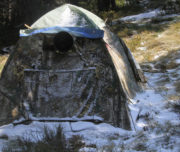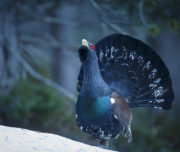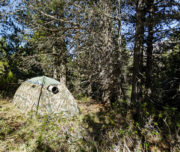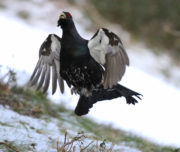Alone in your hide, in the hearth of an old remote forest, let yourself tucking by this mysterious atmosphere, and wake up surrounded of displaying capercaillies.
During the mating season (spring), it is possible to find and observe, quite closely, the capercaillies which perform their special mating display. For photographers and naturalists, we can offer strategic hides so you can enjoy this spectacle without disturbing the birds.
Around the middle of April, the capercaillie begins its display and this lasts until the beginning of June. It’s during this period that this shy creature can be easily observed.
It is at the height of the birds’ activity that we offer you the privilege of spending the night by a lek in a hide specially built for this use, witnessing this magical spectacle.
He is not slow in showing off, opening is tail into a fan and making himself noticed by hopping and starting a strange aria to intimidate the other males and attract the attention of the hens.
From year to year, during the season, numerous males gather in the lek and compete to obtain the favours of the females; intimidating, flapping their wings, attacking with their beaks: each one defending its own particular area where he hopes to attract the hens.
The cocks settle at dusk at the lek where they remain until the following day after they finish their display.
| Destination: | Andorran Pyrenees |
| Dates: | May 1 to 31 |
| Available places per day: | 3 persons (minimum 2 persons) |
| Duration: | two half days and one night |
| Place of arrival and departure: | Andorra |
| Price of trip: | 270 € |
you can also reserve for several consecutive nights.
- Even if the capercaillie is less timid during the courting season, the lek is still a very sensitive place against disturbances and must be treated as a real sanctuary. The main rule to follow is: complete respect for the place and the birds so as not to interrupt, for any reason, the courting process, nesting and hatching. For this reason, access to the hide will be allowed before the arrival of the birds at the lek (about 6 : 00 PM) and the observers will not be allowed to leave until an hour after the birds’ departure (usually about 10 o’clock the following day). Each person must remember that they cannot leave the hide and must take the things that may be necessary for bodily functions
- Once settled in the hide, the norm is complete silence and discretion. The instructions for correct behaviour will be explained the same day
- This sensitive species is protected by strict rules and for this reason any inadequate behaviour on the part of the watchers will lead to the immediate expulsion from the hide. In this case the person concerned will not be refund.
- The beginning of the courting season can vary according to the year and the meteorological conditions. The organization reserves the right to change the dates or cancel the departures if they consider that conditions will not be suitable for good bird watching. In this case the agency will refund the client.
- The weather conditions in the Pyrenees are very changeable in spring; strong winds, showers, storms with thunder or snow: all is possible! In the case of extreme conditions, the organization reserve the right to cancel the departures. In this case the agency will refund the client.
- Even if the move to the hide is relatively short (less than an hour) and a moderate climb (less than 350 meters), the mountain is still unpredictable and you need to be prepared. So the trek will be led by a professional guide.
- Suitable walking boots, another pair of thick socks, fleeces, an anorak, gloves, a head lamp, and a sleeping bag: have the right equipment because the mountain is a place where the weather is very variable and can change quickly!
- If you do not have a sleeping bag, we can rent one to you.
Day 1:
Day 2:
Departure at 10a.m. After having collected the material and returning to the vehicles, we provide morning tea or a mountain picnic, depending on the time, to get back your strength from the previous day! The trip ends between 12 and 2 o’clock.
Note : il est possible de réserver pour plusieurs nuits d’affilée
- Un sac de couchage pouvant vous permettant de faire front à des températures extérieures de -10ºC (et oui !)
- Un tapis de sol
- Une lampe frontale
- Un réveil : vous venez pour voir les oiseaux, pas pour dormir !
- Une bouteille ou récipient pour effectuer vos besoins naturels (il est interdit de sortir de l’affût).
- Chaussures de montagne
- 2 paires de chaussettes épaisses
- Polaire, anorak, gants, bonnet
- Vos effets personnels
- Un sac à dos pouvant contenir le tout : prenez un sac à dos susceptible de contenir TOUT votre matériel, et non 2 sacs à dos, ce qui est franchement très peu commode pendant la marche d’approximation.
- Imperméable











